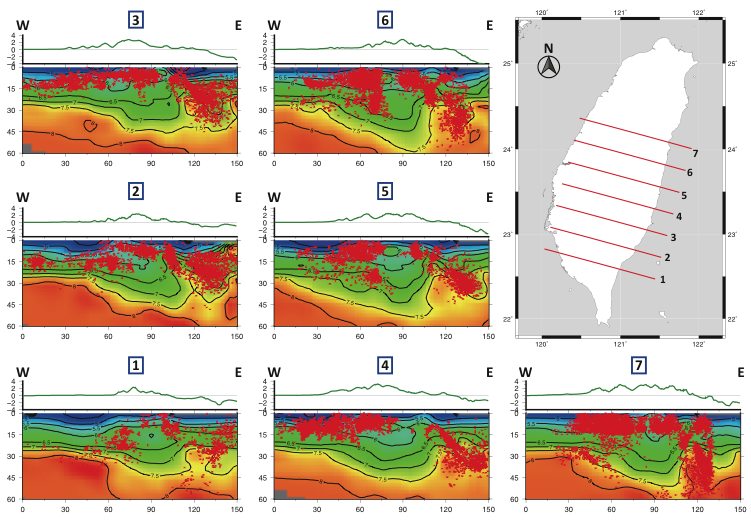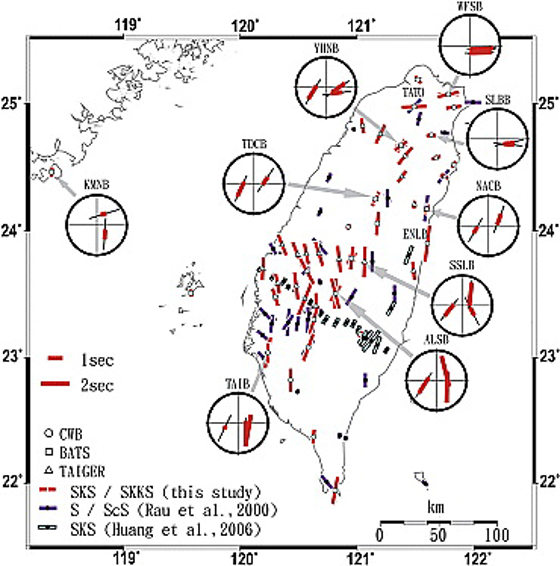Real-Time Earthquake Monitoring with Deep Learning: A Case Study of the 2025 M6.4 Dapu Earthquake in Southwestern Taiwan
- 3D NonLinLoc earthquake catalog for the 2025 ML6.4 Dapu earthquake sequence from January 20 to February 3, 2025.
- link.
Kuo-Chen, H., W.-F. Sun, L.-Y. Kan, S.-Y. Pan, I.-C. Yen, S.-H. Liang, Z.-K. Guan, Y.-H. Liu, W.-S. Chen, and D. Brown, 2025. Real-Time Earthquake Monitoring with Deep Learning: A Case Study of the 2025 ML 6.4 Dapu Earthquake and Its Fault System in Southwestern Taiwan, The Seismic Record. (xx), 1, doi: 10.1785/0320250023.
Sun, W. F., S. Y. Pan, Y. H. Liu, H. Kuo-Chen*, C. S. Ku, C. M. Lin, C. C. Fu, 2025. A deep-learning-based real-time microearthquake monitoring system (RT-MEMS) for Taiwan. Sensors 25, 11, 3353, https://doi.org/10.3390/s25113353
Kuo-Chen, H.; Sun, W.; Huang, C.; Pan, S. Near real-time seismic data processing helps scientist understand aftershocks. Temblor. 2022. doi: 10.32858/temblor.276
Sun, Wei-Fang, Sheng-Yan Pan, Chun-Ming Huang, Zhuo-Kang Guan, I-Chin Yen, Chun-Wei Ho, Tsung-Chih Chi, Chin-Shang Ku, Bor-Shouh Huang, Ching-Chou Fu, Hao Kuo-Chen*, 2024. Deep Learning-based earthquake catalog reveals the seismogenic structures of the 2022 MW 6.9 Chihshang earthquake sequence, Terr. Atmos. & Ocean. Sci., 35, 5. https://doi.org/10.1007/s44195-024-00063-9
Lomax, A.; Virieux, J.; Volant, P.; Berge-Thierry, C. Probabilistic Earthquake Location in 3D and Layered Models. Advances in Seismic Event Location. 2000, 101-134. doi:10.1007/978-94-015-9536-0_5
Kuo‐Chen, H.; Wu, F. T.; Roecker, S. W. Three‐dimensional P velocity structures of the lithosphere beneath Taiwan from the analysis of TAIGER and related seismic data sets. Journal of Geophysical Research: Solid Earth. 2012, 117(B6). doi: 10.1029/2011jb009108
Deep learning-based earthquake catalog of the 2022 MW 6.9 Chihshang, Taiwan, earthquake sequence
On 18 September 2022, the MW 6.9 Chihshang earthquake struck the southern Longitudinal Valley, Taiwan. We use SeisBlue, a deep-learning platform/package, to extract the two-month earthquake sequence from September to October 2022, including the MW 6.5 Guanshan foreshock, the MW 6.9 mainshock, over 14,000 aftershocks, and 866 focal mechanisms from two sets of broadband networks. For more details, please refer to our research article published at TAO (Sun et al., 2024; https://doi.org/10.1007/s44195-024-00063-9). The refined SeisBlue earthquake, FMS, and 20-year M3+ relocated CWA earthquake catalogs obtained in this study are listed here.
- The refined, deep-learning-based earthquake catalog of the 2022 Mw 6.9 Chihshang, Taiwan, earthquake sequence contains 5,151 seismic events with event time, location and error information, local and moment magnitudes, and hypoDD location.
- The FMS (focal mechanism solution) catalog is obtained by the P-wave polarities of 14 broadband stations and the FPFIT program (Reasenberg & Oppenheimer, 1985). 865 out of 1629 FMSs with at least six readings of P-wave polarity, F-fator ≤ 0.1 (F < 0.5 for a good fit), and errors of strike, dip, and rake are all < 20°, respectively, are listed in the attached FMS catalog.
- The 2001-2020 3D-hypoDD-relocated M3+ CWA earthquake catalog: We applied the HypoDD program (Waldhauser & Ellsworth, 2000) to the CWA (Central Weather Administration (CWA, Taiwan), 2012) catalog with P- and S-wave arrivals and obtained 5862 M3+ events between 2001 and 2020 for eastern Taiwan. The 3D velocity models used for this catalog are the local models from Kuo-Chen et al. (2012).
2024_Sun_TAO_2001-2020_CWA_3DhyooDD data download from GoogleDrive
2024_Sun_TAO_2022CS_FMS data download from GoogleDrive
2024_Sun_TAO_2022CS_SeisBlue_EQ data downlad from GoogleDrive
Sun, W. F., Pan, S. Y., Huang, C. M., Guan, Z. K., Yen, I. C., Ho, C. W., Chi, T. C., Ku, C. S., Huang, B. S., Fu, C. C. & Kuo-Chen, H. (2024). Deep learning-based earthquake catalog reveals the seismogenic structures of the 2022 MW 6.9 Chihshang earthquake sequence. Terr Atmos Ocean Sci 35, 5. https://doi.org/10.1007/s44195-024-00063-9
Central Weather Administration (CWA, Taiwan). (2012). Central Weather Administration Seismographic Network [Data set]. International Federation of Digital Seismograph Networks. https://doi.org/10.7914/SN/T5.
Kuo‐Chen, H., Wu, F. T., & Roecker, S. W. (2012). Three‐dimensional P velocity structures of the lithosphere beneath Taiwan from the analysis of TAIGER and related seismic data sets. J. Geophys. Res. Solid Earth, 117(B6). https://doi.org/10.1029/2011JB009108
Reasenberg, P.A., & Oppenheimer, D. (1985). FPFIT, FPPLOT and FPPAGE; Fortran computer programs for calculating and displaying earthquake fault-plane solutions. US Geol. Surv. Open-File Rep., 85-739.
Waldhauser, F., & Ellsworth, W. L. (2000). A double-difference earthquake location algorithm: Method and application to the northern Hayward fault, California. Seismol. Soc. Am., Bull., 90(6), 1353-1368.
Waldhauser, F. (2001). HypoDD: A computer program to compute double-difference earthquake locations, U.S. Geol. Surv. Open-File Report, 01-113, Menlo Park, California.
Taiwan velocity model (Kuo-Chen, Wu, and Roecker, 2012, JGR; Kuo-Chen et al., 2012, GRL):
- TAIGER 3D local Vp velocity model maintained by IRIS
- Taiwan Velocity Models maintained by TEC

Kuo-Chen, H., F. T. Wu, and S. W. Roecker (2012) Three-Dimensional P Velocity Structures of the Lithosphere Beneath Taiwan from the Analysis of TAIGER and Related Seismic Data sets, JGR, doi:10.1029/2011JB009108
Kuo-Chen, H.,F. Wu, D.M. Jenkins, J. Mechie, S. Roecker, C.-Y. Wang, and B.-S.Huang (2012) Seismic evidence for the α-β quartz transition beneath Taiwan from Vp/Vs tomography, Geophys. Res. Lett., doi:10.1029/2012GL053649
Taiwan SKS splitting data (Kuo-Chen et al., 2009, GRL)
- 2009 SKKS data download from GoogleDrive

Kuo-Chen, H., F. T. Wu, D. Okaya, B.-S. Huang, and W.-T. Liang (2009) SKS/SKKS Splitting and Taiwan Orogeny, Geophys. Res. Lett., doi:10.1029/2009GL038148
